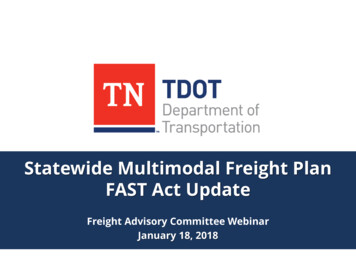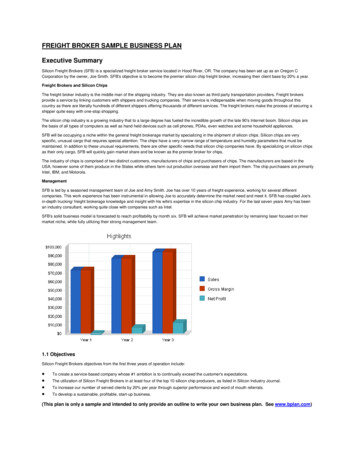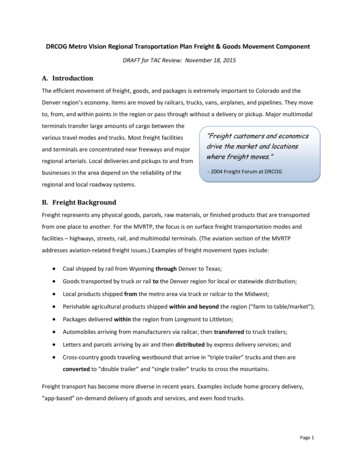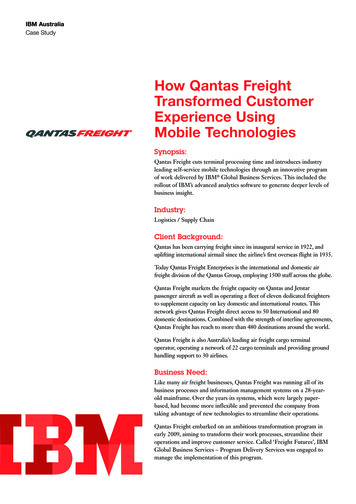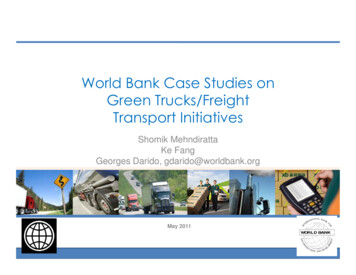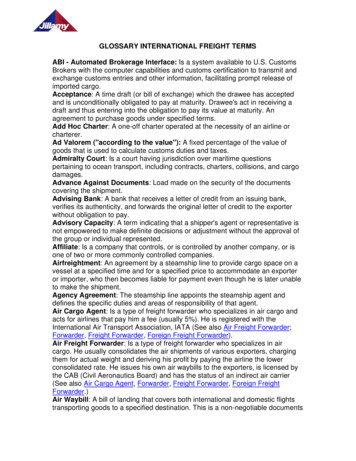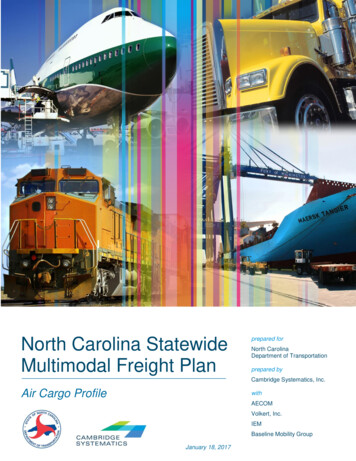
Transcription
North Carolina StatewideMultimodal Freight Planprepared forNorth CarolinaDepartment of Transportationprepared byCambridge Systematics, Inc.Air Cargo ProfilewithAECOMVolkert, Inc.IEMBaseline Mobility GroupJanuary 18, 2017
reportNorth Carolina Statewide MultimodalFreight PlanAir Cargo Profileprepared forNorth Carolina Department of Transportationprepared byCambridge Systematics, Inc.730 Peachtree Street NE, Suite 500Atlanta, GA 30318AECOMVolkert, Inc.IEMBaseline Mobility GroupdateJanuary 18, 2017
North Carolina Statewide Multimodal Freight PlanTable of Contents1.02.0Overview . 1-11.1Methods and Data Overview . 1-11.2Section Organization. 1-2Inventory – Supply . 2-12.1Airport Facilities . 2-12.2Freight Significant Facilities . 2-42.33.02.2.2Piedmont Triad International (GSO) . 2-72.2.3Raleigh-Durham International (RDU). 2-112.2.4North Carolina Global TransPark. 2-14Air Cargo Service Providers . 2-17Air Cargo Activity and Demand . 3-13.1.1Statewide Demand. 3-13.1.2Charlotte Douglas International (CLT) . 3-53.1.3Piedmont Triad International (GSO) . 3-63.1.4Raleigh-Durham International (RDU). 3-83.1.5North Carolina Global TransPark . 3-10Future Performance and Long-Term Trends . 4-14.1Future Activity and Demand Statewide . 4-14.2Future Activity and Demand at Top Airports . 4-44.35.0Charlotte Douglas International (CLT) . 2-4Network Usage and Performance . 3-13.14.02.2.14.2.1Charlotte Douglas International (CLT) . 4-44.2.2Piedmont Triad International (GSO) . 4-64.2.3Raleigh-Durham International (RDU). 4-7Trends and Implications of Growth . 4-8Needs Assessment . 5-15.1Airport Access Needs . 5-15.2Airport Runway/Facility Needs . 5-25.3Industrial Development Needs . 5-3Appendix A.SCTG Commodity Classification . A-1Cambridge Systematics, Inc.i
North Carolina Statewide Multimodal Freight PlanList of TablesTable 2.1Piedmont Triad International Airport Air Cargo Building Space/Tenant Inventory, 2010 . 2-10Table 2.2Public- and Private-Sector Employers at Global TransPark. 2-14Table 2.3Top Air Cargo Carriers at North Carolina Airports, 2015 . 2-18Table 3.1Top North Carolina Air Cargo Trade Partners, 2015 . 3-1Table 3.2Total Air Cargo Activity in North Carolina, 2015 . 3-2Table 3.3Top 10 Commodities by Tonnage at North Carolina Airports, 2015 . 3-4Table 3.4Top 10 Commodities by Value at North Carolina Airports, 2015 . 3-4Table 3.5Charlotte Douglas International Top Air Cargo Trade Partners, 2015 . 3-5Table 3.6Top 10 Commodities at Charlotte Douglas International, 2015 . 3-6Table 3.7Piedmont Triad International Top Air Cargo Trade Partners, 2015 . 3-7Table 3.8Top 10 Commodities at Piedmont Triad International, 2015 . 3-8Table 3.9Raleigh-Durham International Top Air Cargo Trade Partners, 2015 . 3-9Table 3.10Top 10 Commodities at Raleigh-Durham International, 2015 . 3-9Table 4.1Projected Top 10 Air Cargo Commodities by Tonnage at North Carolina Airports, LowGrowth Scenario, 2045 . 4-3Table 4.2Projected Top 10 Air Cargo Commodities by Value at North Carolina Airports, LowGrowth Scenario, 2045 . 4-3Table 4.3Projected Top 10 North Carolina Air Cargo Trade Partners, Low Growth Scenario,2045 . 4-4Table 4.4Projected Top 10 Commodities at Charlotte Douglas International, Low GrowthScenario, 2045 . 4-5Table 4.5Projected Top 10 Commodities at Piedmont Triad International, Low Growth Scenario,2045 . 4-6Table 4.6Projected Top 10 Commodities at Raleigh-Durham International, Low GrowthScenario, 2045 . 4-8Table A.1SCTG Commodity Code Descriptions . A-1Cambridge Systematics, Inc.iii
North Carolina Statewide Multimodal Freight PlanList of FiguresFigure 2.1Airports in North Carolina, All Functions, 2015 . 2-2Figure 2.2Airports with Air Cargo Activity in North Carolina, 2015 . 2-3Figure 2.3Charlotte Douglas International Airport Cargo Center Facilities . 2-4Figure 2.4Rail Service near Charlotte Douglas International Airport . 2-6Figure 2.5Access to Piedmont Triad International Airport . 2-8Figure 2.6Piedmont Triad International Airport Airfield Layout . 2-9Figure 2.7Raleigh-Durham International Airport Cargo Facilities . 2-11Figure 2.8Access to Raleigh-Durham International Airport . 2-13Figure 2.9Access to Kinston Regional Jetport and Global TransPark . 2-16Figure 2.10Air Cargo Service Types, North Carolina Airports, 2015 . 2-17Figure 2.11Top Air Cargo Carriers at North Carolina Airports, in Tons, 2015 . 2-18Figure 2.12Top Air Cargo Carriers at Top 3 North Carolina Airports, in Tons, 2015 . 2-19Figure 3.1North Carolina Air Cargo Activity, 2000-2015 . 3-3Figure 3.2Nationwide Air Cargo Activity (Domestic & International), 2000-2015 . 3-3Figure 3.3Charlotte Douglas International Air Cargo Activity, 2000-2015 . 3-5Figure 3.4Piedmont Triad International Air Cargo Activity, 2000-2015 . 3-7Figure 3.5Raleigh-Durham International Air Cargo Activity, 2000-2015. 3-8Figure 3.6Kinston Regional Jetport Air Cargo Activity, 2000-2015 . 3-10Figure 4.1Projected Air Cargo Tonnage in North Carolina, by Direction and Growth Scenario,2015-2045 . 4-2Figure 4.2Projected Total Air Cargo Tons and Value in North Carolina, 2015-2045 . 4-2Figure 4.3Projected Air Cargo Tonnage at Charlotte Douglas International, by Direction andGrowth Scenario, 2015-2045 . 4-5Figure 4.4Projected Air Cargo Tonnage at Piedmont Triad International, by Direction andGrowth Scenario, 2015-2045 . 4-6Figure 4.5Projected Air Cargo Tonnage at Raleigh-Durham International, by Direction andGrowth Scenario, 2015-2045 . 4-7Figure 4.6U.S. Air Cargo Service, in Revenue Ton-Kilometers, 1979-2013 . 4-9Figure 5.1Future Land Acquisition and Airport Development Areas, Piedmont Triad InternationalAirport . 5-3Figure 5.2Potential Land Use Concepts at Raleigh-Durham International Airport . 5-4Cambridge Systematics, Inc.v
North Carolina Statewide Multimodal Freight PlanList of Acronyms3DPThree-dimensional printingAASHTOAmerican Association of State Highway and Transportation OfficialsASMAvailable seat milesBIPBusiness Investment ProgramBTSBureau of Transportation StatisticsCAGRcompound annual growth rateCCOGCentralina Council of GovernmentsCLTCharlotte Douglas International AirportCVGCincinnati/Northern Kentucky International AirportDDTWDouble dual tandemDOTDepartment of TransportationFAAFederal Aviation AdministrationFAFFreight Analysis FrameworkFASTLANEFostering Advancements in Shipping and Transportation for the Long-term Achievementof National Efficiencies Grant ProgramFHWAFederal Highway AdministrationFTZForeign trade zoneGSOPiedmont Triad International AirportGTPNorth Carolina Global TransParkINDIndianapolis International AirportISOKinston Regional JetportJDIGJob Development Investment GrantMEMMemphis International AirportNSNorfolk Southern RailwayOneNCOne North Carolina FundPMFNNational Primary Multimodal Freight NetworkR&DResearch and developmentRDURaleigh-Durham International AirportRTKRevenue ton-kilometersSCTGStandard Classification of Transported GoodsSDFLouisville International AirportCambridge Systematics, Inc.i
North Carolina Statewide Multimodal Freight PlanTSATransportation Security AdministrationULIUrban Land InstituteUPSUnited Parcel ServiceUSPSUnited States Parcel ServiceWACFBoeing World Air Cargo ForecastCambridge Systematics, Inc.ii
North Carolina Statewide Multimodal Freight Plan1.0OverviewThe purpose of the Air Cargo Profile, as part of the North Carolina Statewide Freight Plan, is to catalogueexisting statewide air cargo infrastructure, operations, carriers, markets and shippers. This information willbe used to describe the existing and future conditions, and provide a needs assessment and analysis ofexisting and future trends for air cargo in North Carolina.1.1Methods and Data OverviewInformation and data for this element of the Study has been gathered from multiple sources, including: Bureau of Transportation Statistics (BTS) TranStats Database T-100 Market data provides annualair cargo statistics for all North Carolina airports with reported activity. The data contains domestic andinternational market data reported by U.S. and foreign air carriers, and contains market data by carrierand origin/destination for enplaned freight and mail. Information about freight and mail tonnage, origindestination geographies, and carriers for North Carolina airports came from this data source. Federal Highway Administration’s (FHWA) Freight Analysis Framework (FAF) version 4.1 contains1aggregated annual volume summaries by origin-destination geography (using FAF zones ), mode, andcommodity and provided this information on a historical and forecast basis using a combination of actualdata and modeled behavior. FAF4.1 has a base year of 2012, with annual estimates for 2013 through2015, as well as 5-year increment forecasts through 2045. FAF4.1 provided information on commoditiesand cargo value for North Carolina Airports. RDU Vision 2040 Airport Master Plan, which is not expected to be completed until winter 2016/2017,provided 2040 forecast tonnage estimates for Raleigh-Durham International Airport (RDU), which wereapproved by the Federal Aviation Administration (FAA). The Plan published a compound annual growthrate (CAGR) for air cargo from 2015 to 2040. This growth rate was used to develop the “low growthscenario” for North Carolina’s air cargo markets. 2015 Boeing World Air Cargo Forecast (WACF) is a biennial report that provides an overview of theair cargo industry at the National level. The report summarizes major air trade markets, trends andforecasts for domestic and international markets. These growth rates were used to develop the “highgrowth scenario” for North Carolina’s air cargo markets.The Air Cargo Profile sourced tonnage estimates for the base year (2015) from the BTS T-100 data, andused FAF4.1 commodity distribution for 2012 to allocate BTS figures to Standard Classification ofTransported Goods (SCTG) codes. Value estimates for 2015 were calculated by applying FAF4.1 2012value per ton rates to the BTS tonnage estimates at the commodity level.This Profile also estimates future activity and demand at North Carolina airports for a “low growth scenario”and a “high growth scenario” for air cargo activity statewide, as well as at each of the three primary air cargoairports: Charlotte Douglas International (CLT), Raleigh-Durham International (RDU) and Piedmont TriadInternational (GSO). To calculate the low growth scenario, this analysis applied the growth rate from the1There are four FAF zones in North Carolina: Charlotte area, Greensboro/Winston-Salem/High Point, Raleigh-Durham,and the rest of North Carolina, which covers three distinct portions of the State.Cambridge Systematics, Inc.1-1
North Carolina Statewide Multimodal Freight PlanRDU Vision 2040 to the 2015 BTS tonnage estimates, and used FAF4.1 commodity distribution for 2045 toallocate the forecasted tonnage figures to SCTG codes. Low growth value estimates for 2045 werecalculated by applying FAF4.1 value per ton rates from 2045 to the low growth tonnage estimates at thecommodity level. To calculate the high growth scenario, this analysis applied the growth rates from theBoeing WACF to the 2015 BTS data, taking into account origin/destination pairings anddomestic/international activity. High growth value estimates for 2045 were calculated by applying FAF4.1value per ton figures from 2045 to the high growth tonnage estimates at the commodity level.1.2Section OrganizationThe remainder of the report is divided into four additional sections. Section 2 will detail the inventory/supplyof air cargo activity in North Carolina, which includes air cargo facilities, freight significant corridors, capacity,service and service providers. Section 3 will detail the network use and performance, which focuses on theactivity/demand element of air cargo activity. This section will identify the industries served by air cargo, andhow these connect to the state’s economy, the markets served and connections to global marketplaces, aswell as bottlenecks and deficiencies. Section 4 describes long-term trends for the state, including futureactivity, performance and demand. This section will also discuss statewide trends affecting the air cargoindustry and the implications of growth. Finally, Section 5 will feature an assessment identifying the needsand issues associated with airport access, airport infrastructure and adjacent industrial development.Additionally, Appendix A features a description the SCTG commodity codes, which will be used to discusscommodity flow throughout this report.Cambridge Systematics, Inc.1-2
North Carolina Statewide Multimodal Freight Plan2.0Inventory – SupplyThis section provides an inventory of the supply of air cargo activity in North Carolina. It lists all airportfacilities, highlights the facilities with air cargo activity, and details the facility infrastructure and capacity. Thethree primary airports with reported air cargo activity are Charlotte Douglas International (CLT), PiedmontTriad International (GSO), and Raleigh-Durham International (RDU). This section will also discuss the NorthCarolina Global TransPark (GTP) facility, as well as service providers at North Carolina’s airports.2.1Airport FacilitiesNorth Carolina has 74 publicly-owned airports and nearly 300 privately-owned airports throughout the State,as shown in Figure 2.1. Out of these airports, 9 have regularly scheduled airline service and 4 provide2international service. North Carolina is served by 18 airports with reported cargo activity in 2015, as reportedby the Bureau of Transportation Statistics (BTS), including both dedicated all-cargo operations as well ascommercial passenger belly cargo. Figure 2.2 depicts a map of the 18 airports with reported air cargoactivity throughout the state. Two airports in North Carolina, RDU and GSO, are designated as part of theNational Primary Multimodal Freight Network (PMFN). Thus, these two facilities could be eligible for federalfunding under the FASTLANE grant program or North Carolina's portion of the National Freight Program thatcan be spent on non-highway modes.NC Airports with Cargo Activity2COMMERCIAL SERVICE AIRPORTSGENERAL AVIATION AIRPORTS Asheville Regional Airport (AVL) Clinton Sampson County Airport (CTZ) Charlotte/Douglas International Airport (CLT) Hickory Regional Airport (HKY) Fayetteville Regional/Grannis Field Airport (FAY) Smith Reynolds Airport (INT) Piedmont Triad International Airport (GSO) Dare County Regional Airport (MEO) Pitt-Greenville Airport (PGV) Cherry Point MCAS (N1C) Albert J. Ellis (OAJ) Gastonia Municipal Airport (NC1) Coastal Carolina Regional Airport (EWN) Rocky Mount-Wilson Regional Airport (RWI) Raleigh-Durham International Airport (RDU) Statesville Regional Airport (SVH) Wilmington International Airport (ILM) Person County Airport (TDF)“Frequently Asked Questions”. North Carolina Department of Transportation. Accessed October 13, 2016. Availablefrom: bridge Systematics, Inc.2-1
Airports in North Carolina, All Functions, 2015Cambridge Systematics, Inc.2-2Source:North Carolina DOT; National Transportation Atlas Database.North Carolina Statewide Multimodal Freight PlanFigure 2.1
Figure 2.2Airports with Air Cargo Activity in North Carolina, 2015North Carolina DOT; National Transportation Atlas Database.North Carolina Statewide Multimodal Freight PlanCambridge Systematics, Inc.2-3Source:
North Carolina Statewide Multimodal Freight Plan2.2Freight Significant FacilitiesThis section features descriptions of the three primary airport facilities for air cargo activity. Three airportscomprise 99 percent of air cargo activity in North Carolina: Charlotte Douglas International Airport (CLT),Piedmont Triad International Airport (GSO) and Raleigh-Durham International Airport (RDU). This sectionalso details North Carolina’s Global TransPark facility.2.2.1Charlotte Douglas International (CLT)ththCLT, located in Charlotte, is currently ranked 6 nationwide and 7 globally in the number of passengers andthe volume of cargo enplaning and deplaning at the airport. The airport averages 1,500 operations daily andserves more than 40 million passengers each year, offering nonstop service to nearly 150 destinations,including 37 international destinations. CLT is served by seven domestic carriers, 14 regional carriers, and3three foreign flag carriers. Air cargo is processed at CLT’s Air Cargo Center. The Air Cargo Center, which isadjacent to CLT’s four runways, has a total of approximately 570,000 square feet of available space andapproximately 2.2 million square feet of aircraft ramp space, as shown in Figure 2.3.Figure 2.3Source:3Charlotte Douglas International Airport Cargo Center FacilitiesCharlotte Douglas International Airport “Quick Caller”, 2014.“Quick Caller”. Charlotte Douglas International Airport, 2014.Cambridge Systematics, Inc.2-4
North Carolina Statewide Multimodal Freight PlanAs of 2014, the Air Cargo Center is used by over 60 freight forwarders, customs brokers, and internationalservice providers, over 15 cargo airlines (including cargo lift by commercial carriers), and over 300 truckingcompanies. CLT is also adjacent to a Foreign Trade Zone (FTZ). Since December 2013, there is also anon-site intermodal rail/truck facility. The Air Cargo Center at CLT is able to link freight between air, rail, waterand truck modes, and processed nearly 128,000 tons of air cargo in 2015. Rail connection is provided byboth Norfolk Southern Railway (NS) and CSX. Error! Reference source not found. presents the railconnections near CLT. NS operates an intermodal container facility on the southwest side of CLT, which canprocess up to 200,000 lifts annually and has compatibility with aviation operations. To access the Port ofMorehead City for maritime freight shipments, NS track runs from Charlotte through Greensboro and Raleighto the coast. CSX also operates both east-west and north-south in North Carolina, serving Charlotte. It hasan intermodal terminal and bulk transfer terminal in Charlotte, east of CLT, but does not connect directly to4CLT itself. Additionally, CSX track runs from Charlotte to the Port of Wilmington.In addition to the present facilities, CLT’s Air Cargo Center has the capacity to handle more than 1 millionsquare feet of building space facilities, including 70 additional acres of aircraft ramp space. There arecustom-built facilities including nearly 15,000 square feet of office space, nearly 28,000 square feet of cargowarehouse, and a 21-foot minimum height warehouse clearance, all of which are located on-site and5adjacent to the aircraft ramps.4“North Carolina Maritime Strategy: Existing and Planned Railroad Infrastructure”. North Carolina Department ofTransportation. May 2012. Available nfrastructure.pdf5“Quick Caller”. Charlotte Douglas International Airport, 2014.Cambridge Systematics, Inc.2-5
Rail Service near Charlotte Douglas International AirportCambridge Systematics, Inc.2-6Source:North Carolina DOT; National Transportation Atlas Database.North Carolina Statewide Multimodal Freight PlanFigure 2.4
North Carolina Statewide Multimodal Freight Plan2.2.2Piedmont Triad International (GSO)Piedmont Triad International Airport (GSO) is located approximately 10 miles west of downtown Greensboro,North Carolina. It services the Piedmont Triad Region, which is a manufacturing, trade and financial centerincluding the areas of Greensboro, High Point and Winston-Salem. GSO’s core service area includes 12North Carolina counties and 6 southern Virginia counties, a total population of approximately 1.8 million6people.GSO is a multimodal cargo facility, providing connections to major trucking lines operating terminals near theairport. Error! Reference source not found. shows the rail and highway access in and around the airport.Air cargo companies providing all-cargo services include FedEx, DHL Express, Mountain Air Cargo,TradeWinds, and United Parcel Service (UPS). In addition, a Norfolk Southern (NS) track runs along thesouth of GSO, along W. Market Street, but does not connect directly with the airport. However, there areplans to build a rail spur for a multimodal facility at GSO in the future. In addition, all other airlines providebelly cargo services based on space available, including Allegiant, American Airlines, Delta Airlines, FrontierAirlines and United Airlines.The airfield layout for GSO is shown in Error! Reference source not found. There are four apron areas atGSO dedicated to air cargo services, totaling nearly 227,000 square feet of air cargo apron space. GSO hasFedEx Express’ Mid-Atlantic Air Hub, which is a 1 million square foot facility able to sort up to 24,0007packages per hour for freight destined for various east coast locations. Mountain Air Cargo is FedEx’sexpress cargo carrier. DHL Express leases nearly 15,000 square feet of space at GSO, and TradeWindsprovides both international and domestic air cargo services out of a hangar and apron on the south side ofthe airport. UPS operates both express overnight cargo and ground cargo out of the airport in two separate8facilities.According to GSO’s Airport Master Plan Update from 2010, there was significant vacant space in several ofthe airport’s six onsite air cargo buildings, as shown in Table 2.1. Air Cargo Building #1 was primarilyoccupied by the Piedmont Triad Airport Authority, but had four vacancies totaling 7,500 square feet of itsnearly 30,000 square foot facility. In addition, Air Cargo Building #3 had a sizable vacancy for one tenant,amounting to 37 percent of the building’s square footage. However, it is important to note that this inventorydoes not include FedEx Express’ one million square foot facility, which was recently developed.678Airport Master Plan Update and Strategic Long-Range Visioning Plan. Piedmont Triad International Airport Authority.September 2010. irport-Master-Plan-Update.pdfPiedmont Triad International Airport. Greensboro North Carolina Economic Development Association. May fault/files/pdf/econdev/AirportText.pdfAirport Master Plan Update and Strategic Long-Range Visioning Plan. Piedmont Triad International Airport Authority.September 2010. irport-Master-Plan-Update.pdfCambridge Systematics, Inc.2-7
Access to Piedmont Triad International AirportCambridge Systematics, Inc.2-8Source:North Carolina DOT; National Transportation Atlas Database.North Carolina Statewide Multimodal Freight PlanFigure 2.5
Figure 2.6Piedmont Triad International Airport Airfield LayoutAirport Master Plan Update. Piedmont Triad International Airport Authority, 2010.Note:Buildings are shown in orange; runway/ramp space is shown in blue.North Carolina Statewide Multimodal Freight PlanCambridge Systematics, Inc.2-9Source:
North Carolina Statewide Multimodal Freight PlanTable 2.1Piedmont Triad International Airport Air Cargo Building Space/TenantInventory, 2010BuildingTenantBuilding Area (Square Feet)Air Cargo Building #1Comair (Delta Airlines)Vacant #1Vacant #2Vacant #3Vacant #4Piedmont Triad Airport AuthorityTOTALAir Cargo Building #1ALandmark AviationTOTALAir Cargo Building #2Continental (United Airlines)Aviation Repair TechnologyVacant #1DeltaVacant #2UPSPiedmont Triad Airport Authority –MechanicalQuantemVacant #3U.S. Postal Service (USPS)JetstreamVacant #4Piedmont Triad Airport Authority – 1688,94512,0012,6465,0171,26055,384Air Cargo Building #3Vacant #1TIMCOB & C. DHL (Airborne)Vacant #2Piedmont Triad Airport Authority - radeWinds CargoBuildingHangar BTOTAL24,30024,300UPS-SCS BuildingVacantTOTAL16,80816,808FedEx BuildingMain Sort 01,5003,0002,0001,00019,90529,3253,0003,000Airport Master Plan Update. Piedmont Triad International Airport Authority, 2010.Cambridge Systematics, Inc.2-10
North Carolina Statewide Multimodal Freight Plan2.2.3Raleigh-Durham International (RDU)Raleigh-Durham International Airport (RDU) is situated between the cities of Raleigh and Durham, located afew miles east of
North Carolina Statewide Multimodal Freight Plan Cambridge Systematics, Inc. 1-1 1.0 Overview The purpose of the Air Cargo Profile, as part of the North Carolina Statewide Freight Plan, is to catalogue existing statewide air cargo infrastructure, operations, carriers, markets and shippers. This information will
